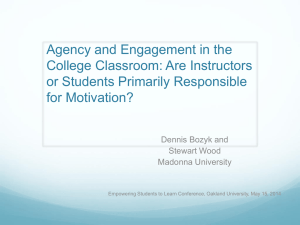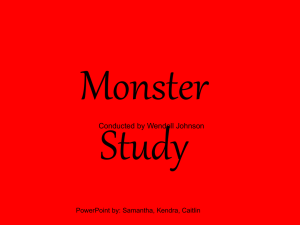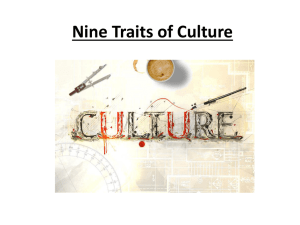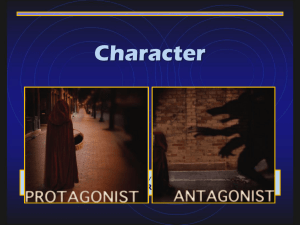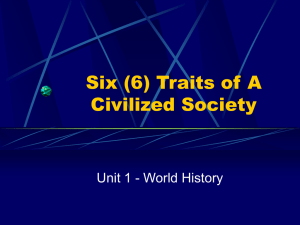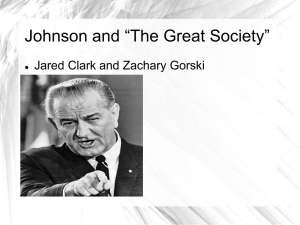Perceptions of the Female Leader
advertisement
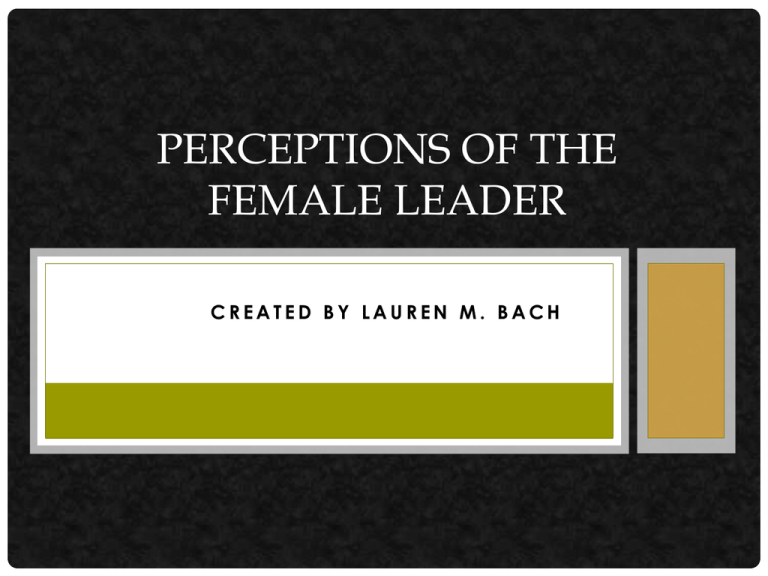
PERCEPTIONS OF THE FEMALE LEADER CREATED BY LAUREN M. BACH RESEARCH TOPIC • Does a prejudice exist towards female leaders? • Role Congruity Theory • Is there a top-level leadership advantage for female leaders? • Double Standards ROLE CONGRUITY THEORY • Eagly and Karau (2002) • Agentic traits & communal traits • Gender consistent roles vs. gender inconsistent roles • Incongruity between female gender roles and leadership traits • = Prejudice towards female leaders JOHNSON ET AL. (2008) • Subjects: 101 community members • Are agentic female leaders evaluated more likeable and effective than agentic male leaders? • Task: Read vignette about a CEO JOHNSON ET AL. (2008) • Four conditions: Female Gender (Joan Davenport) Male (John Davenport) IV Agentic (Strength) Leadership Trait Communal (Sensitivity) JOHNSON ET AL. (2008) • Post questionnaire • Ratings on a 7 point Likert Scale Leader Effectiveness DV Leader Likeability JOHNSON ET AL. (2008) JOHNSON ET AL. (2008) PEACHEY AND BURTON (2011) • Subjects: 112 Athletic Directors • Read leadership vignette Female Gender Male IV Transactional (Agentic) Leadership Style Transformational (Communal) PEACHEY AND BURTON (2011) • Multifactor Leadership Questionnaire • 5-point Likert type scale Leader Effectiveness DV Leader Effort Satisfaction with Leader PEACHEY AND BURTON (2011) Mean Effectiveness Mean Effectiveness Ratings of Leadership 4.4 4.3 4.2 4.1 4 3.9 3.8 3.7 3.6 3.5 Male Female Transformational Transactional Leadership Style Error Bars: +/- 1 SD DOUBLE STANDARDS FOSCHI ET AL. (1994) Top-Level Leadership Position = No Prejudice (Advantage) --------------------“Glass Ceiling” -------------------- Lower-level Leadership Positions = Prejudice ROSETTE AND TOST (2010) • Subjects: 106 graduate & undergraduate students • Given job description and performance summary Female Gender Male IV Senior Executive Vice President Leadership Position Division Manager ROSETTE AND TOST (2010) • Post questionnaire • 7-point Likert Scale Agentic Traits DV Communal Traits Leader Effectiveness Double Standards Feminine Management Style Masculine Management Style ROSETTE AND TOST (2010) Mean Scores Effect of Leader Gender and Position on Leader Perceptions 7 6 5 4 3 2 1 0 * * * * * * * Female Top Leader Male Top Leader Double Standards Leader Effectiveness Dependent Variables Error Bars: +/- 1 SD * Significant p<.05 Female Middle Manager Male Middle Manager MY HYPOTHESIS • Female Senior Executive Vice Presidents will be evaluated as both more agentic and communal, likable, and effective than lower level female Division Managers and male Senior Executive Vice Presidents. METHOD • Subjects: MSU Mankato PSYC 211 and other students • N = 52 (33F, 19M) • Materials: • • • • • Consent Form Articles Questionnaires Debriefing Form Pens PROCEDURE • 4 Article Conditions: • All included job description and performance summary. Percent Earnings Change Figure 1: Percent Earnings Increase Over the Past Six Months 100 80 60 40 Series 1 20 0 1 2 3 4 The Month 5 6 PROCEDURE • Manipulations: Female (Samantha) Gender Male (Sam) IV Senior Executive Vice President Leadership Position Division Manager PROCEDURE DV Agentic Traits Communal Traits Leader Effectiveness Leader Likeability PROCEDURE • Given a Post Questionnaire 1 Strongly Disagree 2 Disagree 3 Slightly Disagree 4 Slightly Agree Johnson may be liked by other staff members. 1 2 3 4 5 6 Johnson may be a bold employee leader. 1 2 3 4 5 6 Johnson may be compassionate to staff concerns. 1 2 3 4 5 6 Johnson may be effective. 1 2 3 4 5 6 5 Agree 6 Strongly Agree RESULTS: AGENTIC TRAITS (NOT SIGNIFICANT) (F(3, 48) = .601, P = .618) RESULTS: COMMUNAL TRAITS (NOT SIGNIFICANT) (F(3, 48) = 1.366, P = .264) RESULTS: EFFECTIVENESS (NOT SIGNIFICANT) (F(3, 48) = 1.609, P = .200) RESULTS: LIKEABILITY (NOT SIGNIFICANT) (F(3, 48) = 1.881, P = .145) DISCUSSION • Results did not support my hypothesis. • Top Female leaders not evaluated more: • • • • Communal Agentic Effective Likeable DISCUSSION • Results not support: • Role congruity theory (Eagly & Karau, 2002) • Johnson et al. (2008) • Results support: • Peachey and Burton (2011) • Results not support: • Double Standards (Foschi et al.,1994) • Rosette and Tost (2010) LIMITATIONS • Small Sample Size • Not Enough Information in Manipulated Articles • Participants Able to Predict Research Topic FUTURE STUDIES • Obtain larger sample size • Modify articles with more information • Further disguise study’s purpose • Eliminate convenience sampling • Procure a diverse sample THE IMPORTANCE Researching prejudice and advantages = More Females in Top Leadership Positions REFERENCES Eagly, A. H., & Karau, S. J. (2002). Role congruity theory of prejudice toward female leaders. Psychological Review, 109, 573-598. doi:10.1037//0033-295X.109.3.573 Foschi, M., Lai, L., & Sigerson, K. (1994). Gender and double standards in the assessment of job applicants. Social Psychology Quarterly, 57, 326339. Retrieved from <http://spq.sagepub.com>. Johnson, S. K., Murphy, S. E., Zewdie, S., & Reichard, F. J. (2008). The strong, sensitive, type: Effects of gender stereotypes and leadership prototypes on the evaluation of male and female leaders. Organization Behavior and Human Decision Process, 106, 39-60. doi:1016/j.obhdp.207.12.002 Peachey, J. W., & Burton, L. J. (2011). Male of female athletic director? Exploring perceptions of leader effectiveness and a (potential) female leadership advantage with intercollegiate athletic directors. Springer Science + Business Media, 64, 416-425. doi:10.1007/s11199-010-9915-y Rosette, A. S., & Tost, L. P. (2010). Agentic women and communal leadership: How role prescriptions confer advantage to top women leaders. Journal of Applied Psychology, 95, 221-235. doi:10.1037/a0018204 THANK YOU! ANY QUESTIONS?
